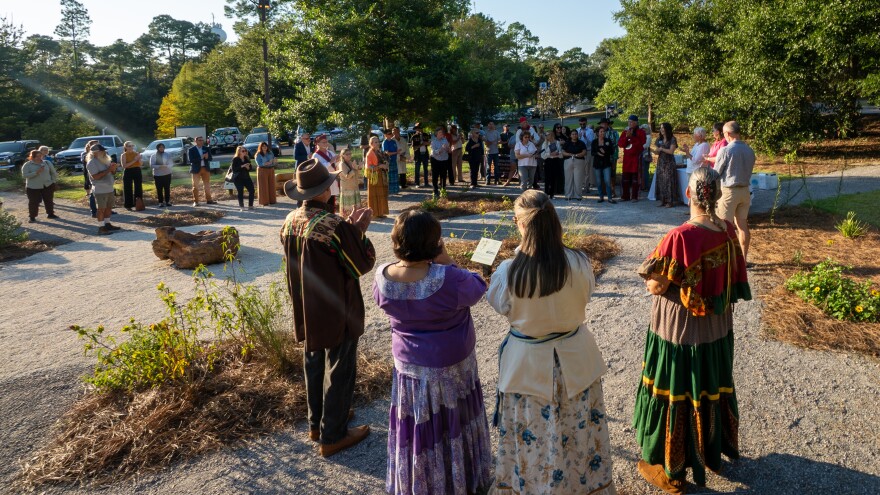The University of West Florida is celebrating local culture and ecology with its newest native plants garden. The new Heritage Roots Garden at the UWF Archaeology Institute opened to the public on Tuesday.
Support Local Stories. Support Public Media.
The driving force behind the Heritage Roots Garden is Nicole Grinnan, assistant director of the Archaeology Institute.
"The University of West Florida's Archaeology Institute has a wonderful museum inside and we had some space outside that I thought would make a wonderful extension," said Grinnan, who pointed out that she and her long-time colleague, Michael Thomin from the Florida Public Archaeology Network, long dreamed about doing an outdoor interpretive space because of their participation in environmental science programs.
“One of the things we felt really strongly about was integrating a lot of what we had learned through the Florida Master Naturalist Program and working with some of our local tribal communities,” she said. “So, we reached out to Chief Dan Helms, who’s a partner with the Santa Rosa Band of the Lower Muscogee. And together we collaboratively came up with this idea of an ethno-botanical garden, which is now the Heritage Roots Garden here. And the idea is to feature native plants that have been used by communities of people in this area for thousands of years.”

The garden includes plants for food, medicine, and other uses, such as swamp hibiscus, red mulberry, American beautyberry, black-eyed Susan, strawberries and two local species of native blueberries.
The garden project was made possible by numerous community partnerships and donations for items such as the landscaping, pathways, and benches. Also, $45,000 in funding came from the Pensacola and Perdido Bays Estuary Program, through its community grants program, which supports science and community education.
“We thought that this garden would make a fantastic candidate for a community grant and they eventually decided to fund our project and have been incredibly patient with us, as it’s taken time to get this installed here at the university,” Grinnan stated. “But, the pay off and return on that investment, I think, has been incredible.”

As noted by Grinnan, Chief Dan Helms has closely collaborated in the creation of the garden. And with numerous members of his tribe on hand, he took part in the opening ceremony for the garden, offering a prayer in the Muscogee language.
After the prayer, those in attendance joined in a sip of Native American “Black Drink,” or yaupon tea.
“Here we used it as a personal medicine or a personal purification to them,” Helms explained.
Previously, before work began, the Chief blessed the garden grounds.
“This is a sacred place, because it has been offered in prayers to make it a sacred place," sad Helms. "And this is a place where we can come and we can listen and we can still ourselves and we can be a part of the natural world right here, right in the middle of all that’s going on."
The Chief also had a hand in the very careful selection of native plants for the garden.

“There’re things in the Native American cosmology called fire colors, which are red and yellow, black and white,” he said. “So a lot of the plants that were chosen were not only for their indigenous, being that they were used in the past. But, they were also chosen for their colors. So when you come back out here to this garden in the spring time, you’ll notice that there will be groupings of red, yellow, black and white plants.”
Further, the garden has been laid out with Native American cardinal directions in mind and it’s formed in the shape of a turtle, which is a sacred animal for the tribe.
“The Muskogee word for turtle is locv (lo-cha), and there are some creation stories that have to do with locv," the chief explained. "So the locv is part of the cosmology that is embedded in this project,” said Helms, adding that the signage for the plants not only has their scientific names, but also lists the name of the plant in the Muscogee language.

Thankful that it has finally come together, Grinnan, invites members of the greater community to come by for a visit.
“This is not just for the University of West Florida. We want all people to come and visit our museum here at the Archaeology Institute, but also the garden,” she said.
And she says there’s more in the works for the new Heritage Roots Garden.
“In development right now is a guided walking tour map that we’ll feature online, so people can learn more about the plants,” said Grinnan. “We have some signs out here, but there is so much more to learn and we’ll have that coming as well in the next few months.”
As a thank you, those who attended the garden’s opening were given a packet containing seeds of the three sisters — corn, beans and squash —traditionally grown together by local Native American communities.


